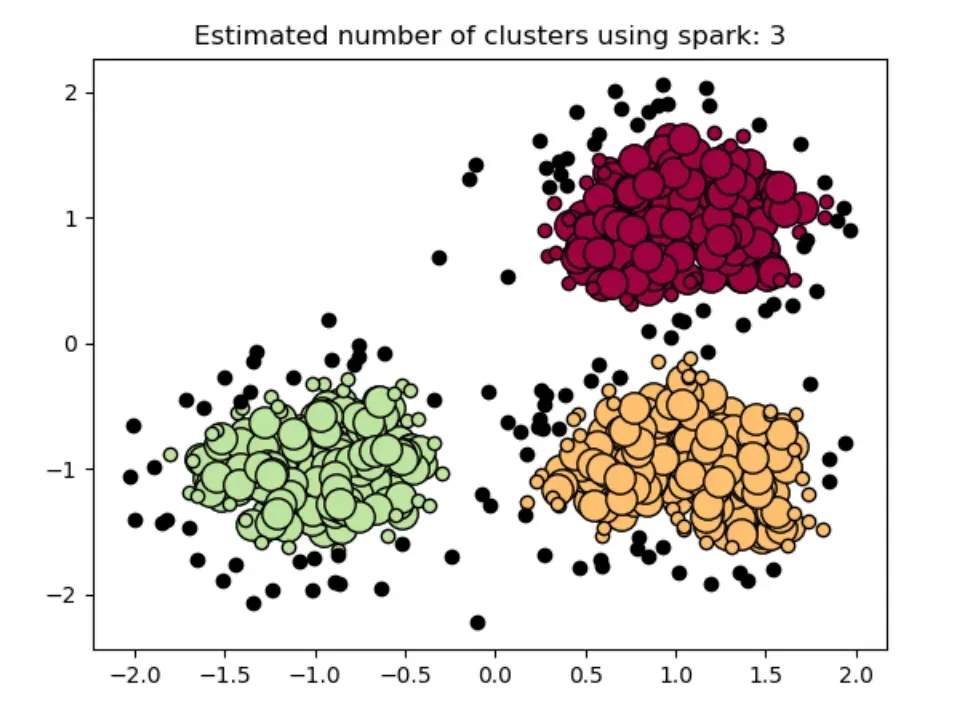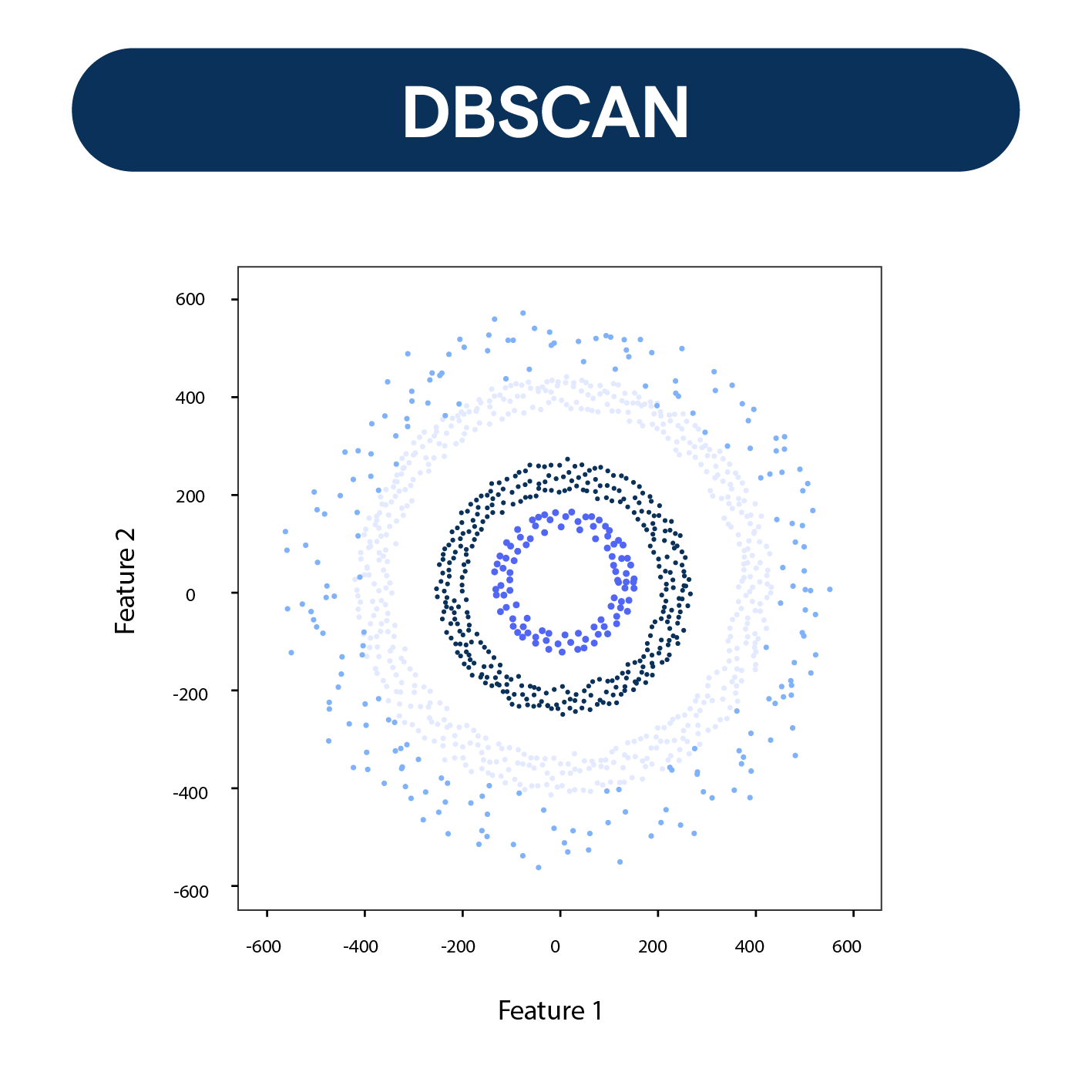What is DBSCAN?
DBSCAN is a density-based clustering algorithm characterized by its ability to discover clusters of different shapes and sizes from large amounts of spatial data.
The algorithm divides the data into high-density and low-density regions. It considers points in high-density areas as normal data points and treats those in low-density areas as noise or outliers.
DBSCAN is particularly effective in applications involving spatial data analysis and anomaly detection because it can identify clusters of any shape, which is not feasible with traditional clustering methods.
DBSCAN is used widely in several fields, including computer vision, data analysis, geographic information systems, machine learning, and image analysis.
When is DBSCAN Used?
Now, let's have a look when DBSCAN comes into play.

In Spatial Data Analysis
DBSCAN can find non-linearly separable clusters, making it perfect for spatial data analysis. Here, clusters are often arbitrary shaped rather than spherical as in k-means.
In Anomaly Detection
DBSCAN can distinguish between noise (anomalies) and part of a cluster, making it effective for anomaly detection in data.
In Image Recognition
It can also be used in image recognition. The extension of DBSCAN, OPTICS, is often used in this field.
In Machine Learning
DBSCAN's ability to handle noise and find arbitrary shaped clusters makes it invaluable in machine learning for clustering tasks.
Where is DBSCAN Used?
Let's explore where the DBSCAN proves to be useful.

Machine Learning Platforms
DBSCAN is integrated into various machine learning platforms including Python's scikit-learn, MATLAB, rapidminer and others for ease of use.
Various Industries
Industries including finance, healthcare, social networking, and ecommerce employ DBSCAN for tasks ranging from customer segmentation, anomaly detection, to predictive analytics.
Research Field
In academia, it's widely used in research related to data mining and knowledge discovery, image processing, and other related fields.
Commercial Applications
In commercial applications, it offers benefits in a variety of sectors such as traffic management, energy management, border control, and many more.
Why is DBSCAN Important?
Moving forward, let's understand the significance of DBSCAN. Why is it so popular?
No Need to Specify Number of Clusters
Unlike other clustering methods, DBSCAN does not require the user to specify the number of clusters in the data beforehand.
Able to Find Arbitrary Shaped Clusters
DBSCAN can find clusters of arbitrary shapes, which can be helpful as clusters in real-world data are often of arbitrary shape.
Good with Handling Noise
DBSCAN classifies outliers as noise thus, it can handle datasets with a large amount of noise.
No Assumption of Cluster Centroid
DBSCAN does not make any assumption of the cluster centroid or other specific numerical targets, providing flexibility in handling a wide range of datasets.
How is DBSCAN Implemented?
Now, let's delve into the operational aspect of DBSCAN. How is it implemented?

Selection of Parameters
In DBSCAN, we need to choose two parameters: Epsilon (eps) and Minimum Points (MinPts).
Here, eps defines the maximum distance between two points for them to be considered in the same neighborhood, while MinPts defines the minimum number of points to form a dense region.
Locating Core Points
Using eps and MinPts, DBSCAN starts by arbitrariously selecting a point, and then retrieving all points within eps radius. If number of points within eps radius equals or exceed MinPts, a new cluster is created.
Expanding Clusters
DBSCAN then iteratively adds all directly reachable points in the eps neighborhood to the cluster. This process continues until no more points can be added to the cluster.
Identifying Noises
Finally, DBSCAN identifies all points not belonging to any cluster as noise or outliers, effectively completing the clustering process.
Frequently Asked Questions (FAQs)
What is the advantage of DBSCAN over other clustering algorithms?
DBSCAN has the unique capability to find arbitrarily shaped clusters and deal effectively with noise in datasets.
How does DBSCAN identify outliers?
DBSCAN treats all points not part of a cluster as noise or outliers in the dataset.
What parameters does DBSCAN require for implementation?
DBSCAN requires two parameters for implementation: radius of neighborhood (eps) and minimum points required to form a dense region (MinPts).
Can DBSCAN be used for large datasets?
Yes, DBSCAN can be used for large spatial datasets. Though it might require more computational resources.
What is the downside of using DBSCAN?
Choosing appropriate values for eps and MinPts can sometimes be challenging, and DBSCAN can respond poorly if the density varies significantly throughout the dataset.

